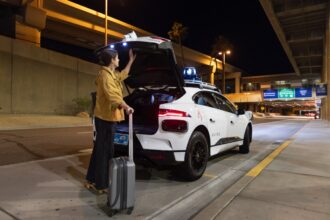Waymo has started testing a new robotaxi built by Chinese electric automaker Zeekr on public roads in San Francisco.
Waymo has “less than a handful” of the Zeekr vehicles in San Francisco today and isn’t driving them autonomously yet. Still, the fact that Waymo has hit the roads with a roomier, custom-built robotaxi signals the next phase of the Alphabet-owned company’s autonomous vehicle technology journey. The public testing milestone has been several years in the making. Waymo first announced plans to build an electric autonomous ride-hail vehicle with Zeekr for the U.S. market in December 2021.
Waymo uses Jaguar I-Paces, retrofitted with its fifth generation Driver, for its commercial robotaxi operations. And for those who have ridden in one with a group, it can be a tight squeeze.
The new minivan-esque vehicle, which appears to be modeled after Zeekr’s upcoming Zeekr 009 minivan, is outfitted with Waymo’s sixth generation hardware — a more cost-effective set of sensors than previous versions that is also designed to operate in winter environments.
“Our fourth generation, which was just on the [Chrysler] Pacificas, were vital to helping us prove that we can operate fully autonomously or go rider only,” Waymo spokesperson Sandy Karp told TechCrunch. “The fifth generation hardware was critical to help us scale to four cities as of now, as well as navigate dense urban environments. The sixth generation hardware builds on those capabilities, but it has a much more simplified design. It brings down the cost significantly, and it will help us operate autonomously in colder cities.”
It’s not clear when Waymo will launch in cities that experience wintry weather conditions. Last winter, Waymo tested its robotaxis in Buffalo, New York and has since left the city. Karp said Waymo continues to test its driver on winter roads in simulation during the summer months, and will test again in another cold climate later this year.
Karp noted that while Waymo is laser-focused on scaling its Waymo One ride-hailing service in the cities where it currently operates – Phoenix, San Francisco, Los Angeles and Austin – the sixth generation Driver is what will help it expand.
But first, the sixth-gen hardware needs to be rigorously tested. Waymo isn’t only testing its upgraded sensor suite – which includes in-house designed and built lidar, radar, cameras and microphones – in cold environments. The company has also been putting the hardware through its paces in extra hot climates like Death Valley and Las Vegas.
“Thermal stability is a huge thing for cameras to make sure they don’t get distorted by the extreme heat or the extreme cold,” said Karp.
Waymo’s fleet of Zeekr test vehicles is still small. In San Francisco, Waymo said it has less than a handful of Zeekrs on the road today. But it’s an interesting moment to introduce a smart vehicle with ties to China. Zeekr is owned by Chinese auto giant Geely Automotive.
Earlier this month, the U.S. Commerce Department said it plans to issue proposed rules on connected vehicles in August and expects to impose limits on software made in China and other adversarial countries. This comes a few weeks after U.S. Rep. Elissa Slotkin soft launched a bill that she plans to introduce to Congress that would limit or ban the introduction of Chinese connected vehicles.
To be clear, the Waymo-Zeekr vehicle doesn’t include software or sensors produced by Zeekr. The vehicles are designed and engineered in Sweden and the prototype vehicles are manufactured in China. The Waymo Driver, which includes hardware and software, is integrated into the base vehicles in the U.S.
To that end, Waymo recently submitted public comments to the Commerce Department’s advance notice of proposed rulemaking on connected vehicles, explaining that the Zeekr-provided base vehicles “have no driving automation or telematics capabilities built into them.”
There are, of course, other AV companies with ties to China that are testing in California. The state’s Department of Motor Vehicles, which regulates testing and deployment permits issued to autonomous vehicle companies, told TechCrunch that it aligns its regulations with national regulations. Meaning that until Congress or the National Highway Transportation Safety Administration comes forward with a ruling about Chinese connected vehicles, the DMV will not change the way it issues permits.
China connections aside, a spokesperson for the DMV told TechCrunch that Waymo would need to apply to add a new vehicle to its existing drivered and driverless testing permits if it wants to test the Zeekr autonomously.
The California Public Utilities Commission, which regulates how AV companies can charge passengers for rides, said that novel vehicles don’t necessarily require a new authorization from the agency. The carrier may need to request certain exemptions to remain in compliance with CPUC regulations, though, like if a purpose-built AV were not equipped with things like a steering wheel or pedals.
The Zeekr prototype vehicle has a removable steering wheel, and the goal down the line is to operate it without one.
Source : Techcrunch



